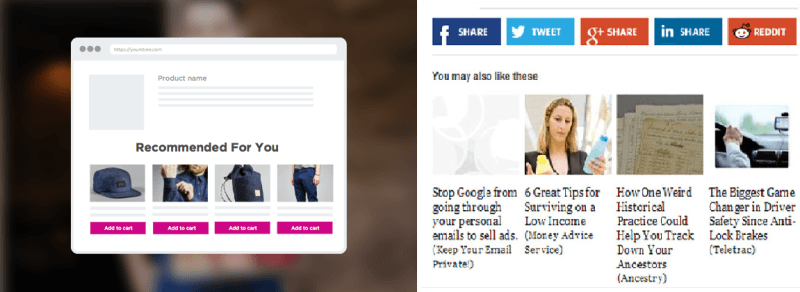Introduction to Recommendations
A recommendation engine applies machine learning to user interaction profiles in order to surface the most relevant items (content or products) to each customer in their journey. Its primary aim is to increase cross-sells and up-sells in a retail environment, or engagement in the case of content, by helping customers find what they need or new items they would not have otherwise found themselves. For example:
A recommendations campaign is not always about products in a standard retail scenario. For this reason, we mostly use the term Item recommendations. An item can be a product or a piece of content, such as an article or a blog post.
An item can be characterized by the following elements:

|
|
For recommendations to be generated, the recommendations engine needs to understand users’ behaviors (User Behavior Tracking) as well as have access to a list of items (Inventory) it can recommend from.
Configuring the User Behavior Tracking via a tag and the inventory upload, as well as attribute mapping, are part of the one-time setup.
Recommendations are produced by:
- The AI/machine learning engine based on the model selected.
- The filtering conditions applied (for example, recommending only in stock items, or on sale items).
- The parameters passed in the request such as the ID of a currently viewed item or user interactions history (for example, views and purchases).
You have the option of using Popularity and Personalized Recommendations models.
A single request to the recommendation’s engine can return up to 50 recommendations.
Recommendations can be embedded into marketing emails or on web pages that the users interact with. Recommendations can also be classified based on when they are generated for the user into the below mentioned categories:
- Real-time recommendations
On the web, recommendations are always generated in real time whenever a user opens a web page containing a recommendations module or refreshes an already opened one. It is built on real-time data for each user at the point in time when the web page is opened.
- Sent-time recommendations
Sent-time email recommendations refer to recommendations that are generated when the email is actually sent (send time).
- Open-time recommendations
Open-time email recommendations refer to real-time recommendations. It is built on real-time data for each user at the point in time when the email is opened and read and not when the email is sent (send time). The recommendations are not predefined but instead are rendered upon opening of the email by each individual recipient. The content predictions are made using the recipient’s tracked behavior. Rather than blasting the same recommended content or product, this capability allows marketers to personalize their campaigns with real-time tailored recommendations, based on up-to-date user onsite behaviors and affinities.
This type of personalization is quite powerful when there are scenarios where there is a need to show recommendations with respect to latest offers, price changes, stock availability, and so on.
For instance, one of your users looked at an Item in your online store. On session abandonment, an automated email is triggered containing recommendations matching the items they looked at.
Through the week, this user browses the website again, checking out new products and making purchases. When this customer opens that same email a week later, with open-time capability, the recommendations will have been adjusted to reflect this user’s newly learned preferences, even though the email was sent prior to their purchase. This can also consider and check for stock availability, offers, and so on.
The following Recommendations capabilities are present across channels:
|
Channels |
|
|
Inventory Size |
|
|
Algorithms |
|
|
Filters |
|
Creating Recommendations Service and Getting Recommendations Using REST API
Adding Recommendations to a Website Using Web Personalization
